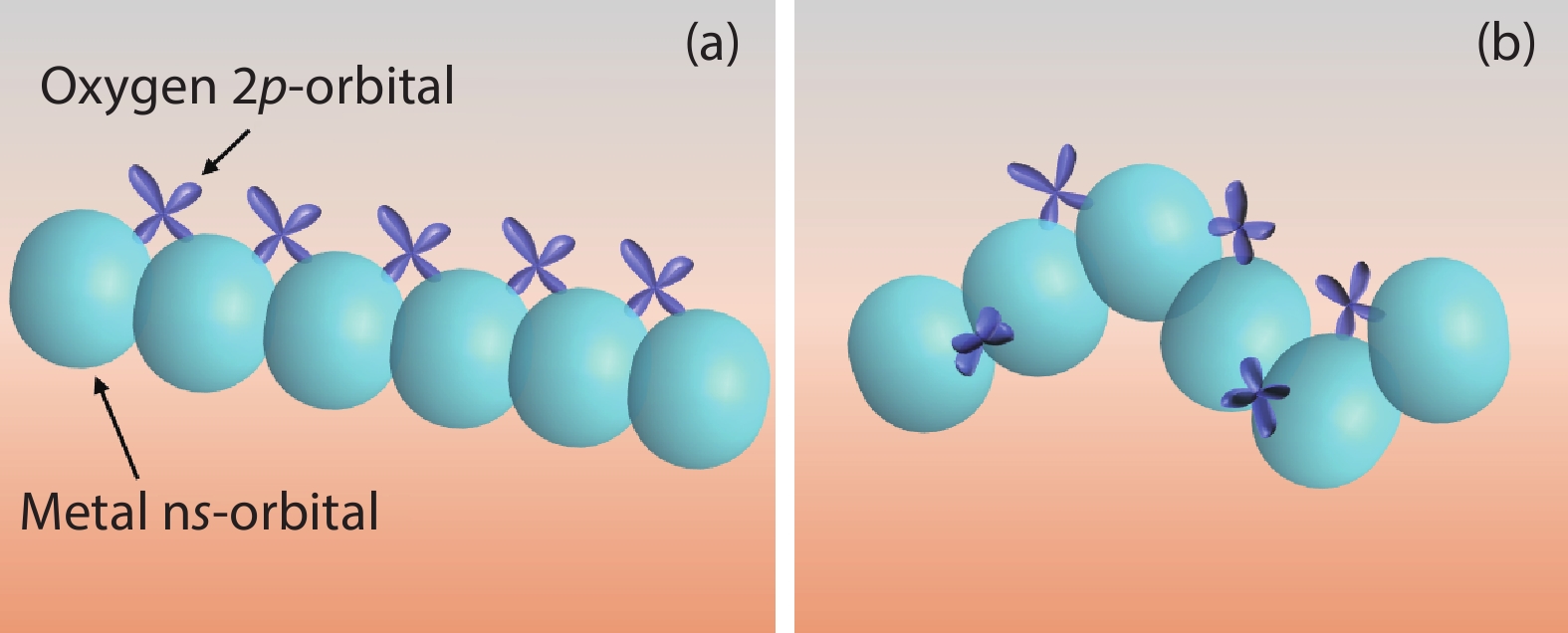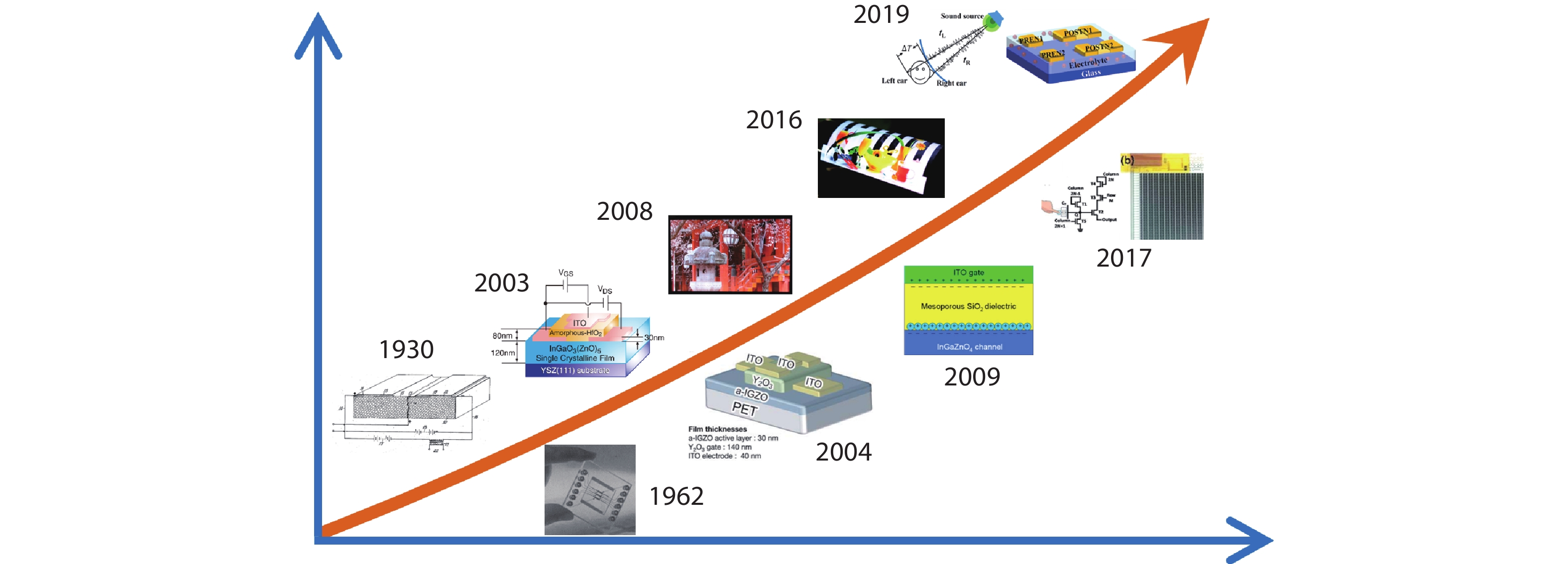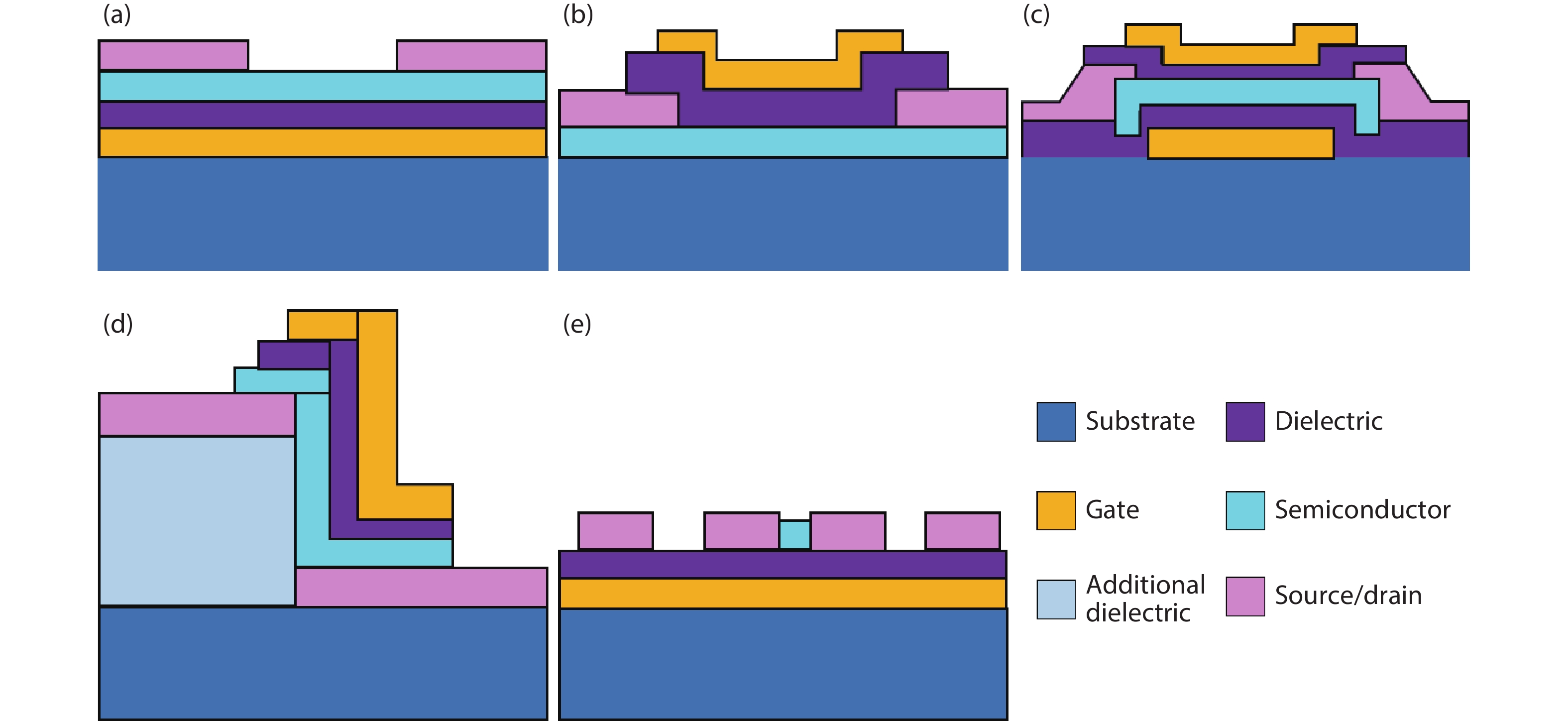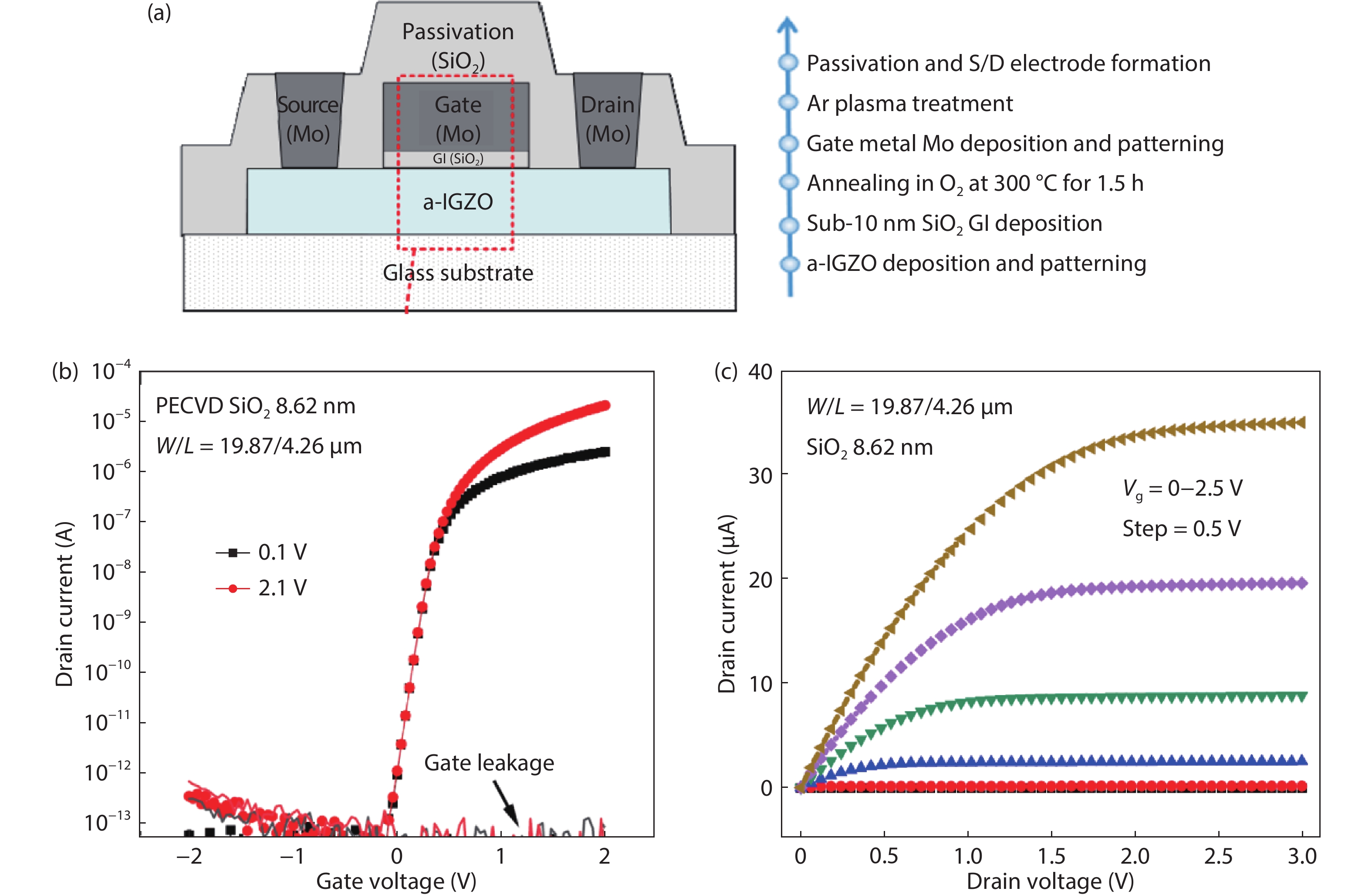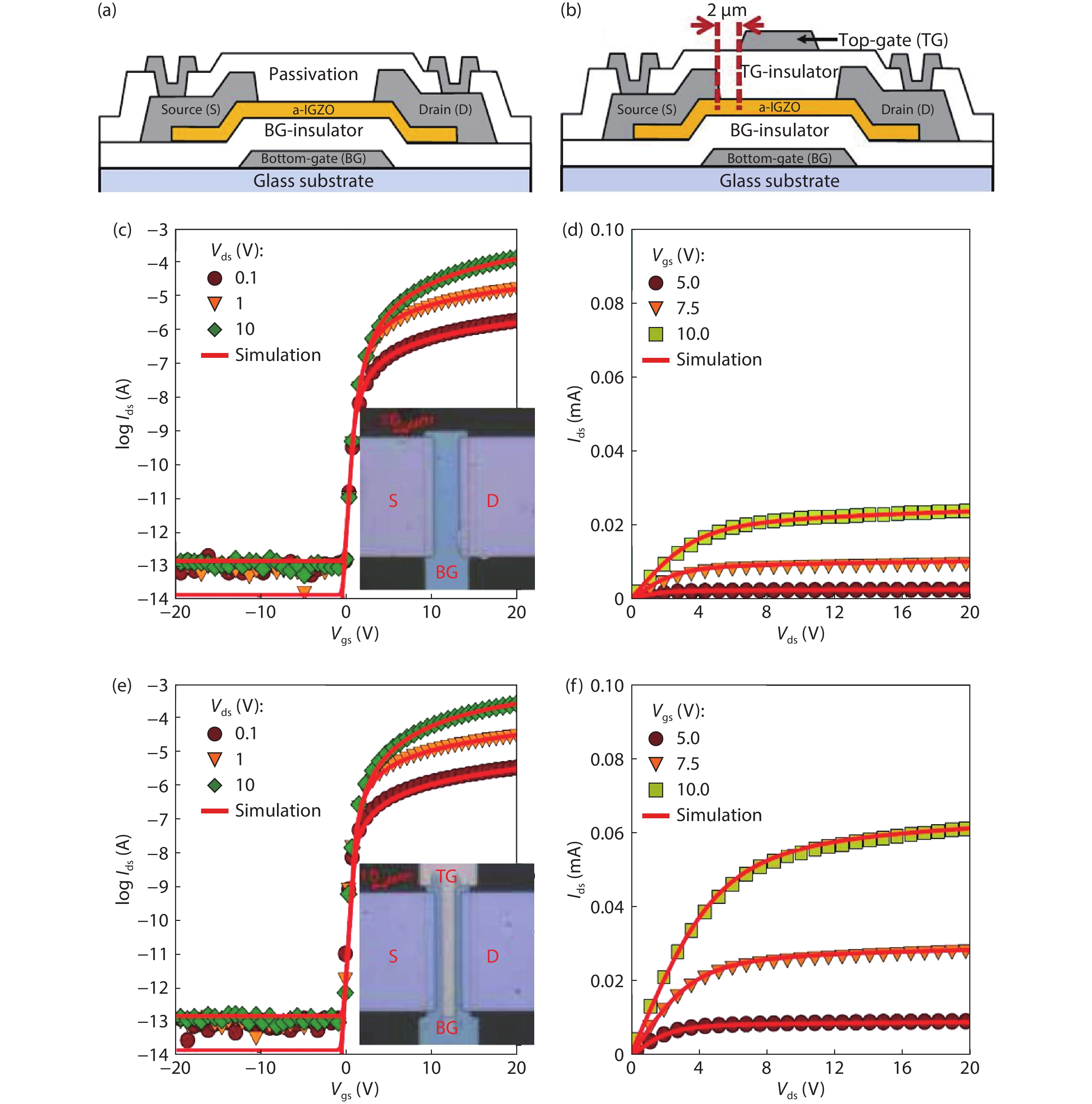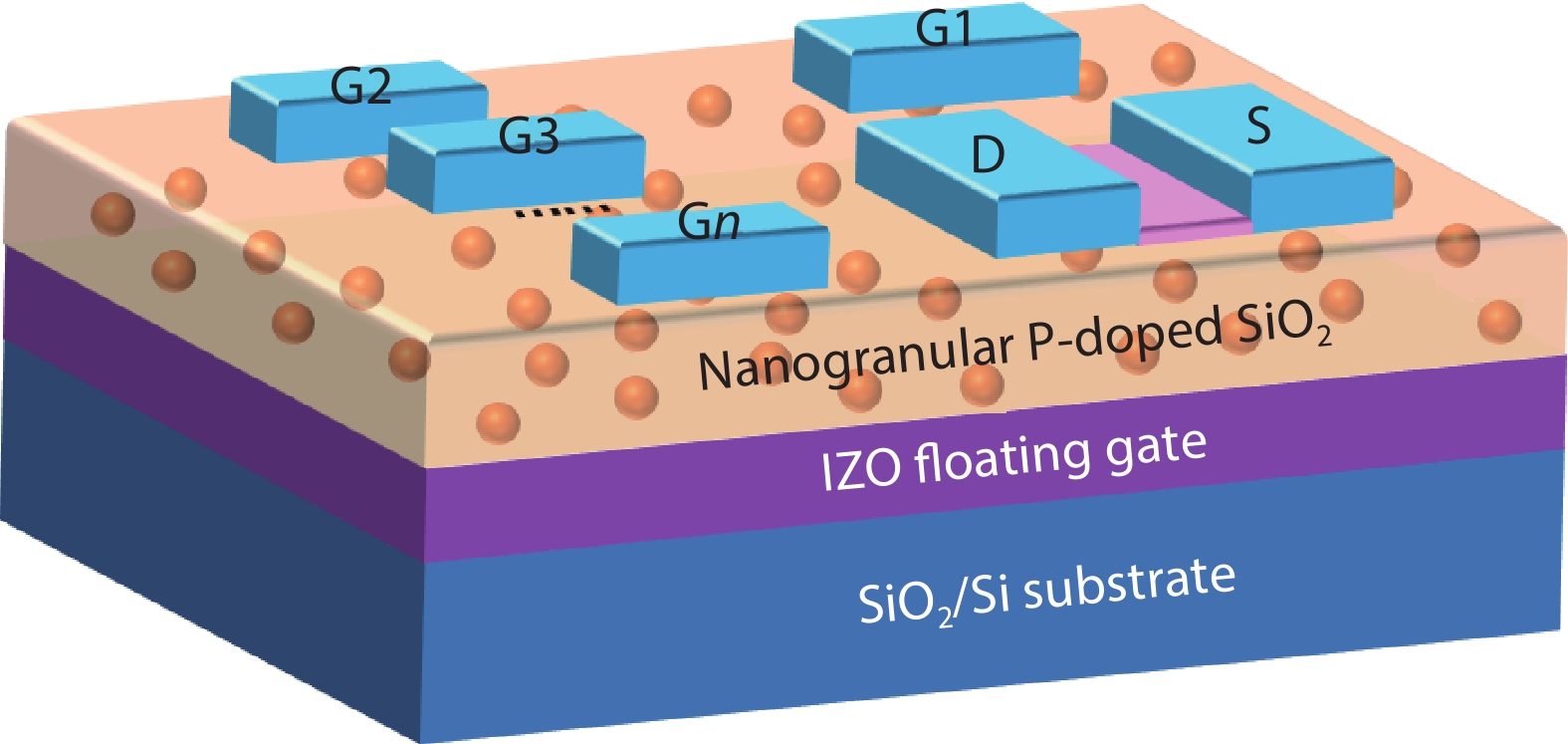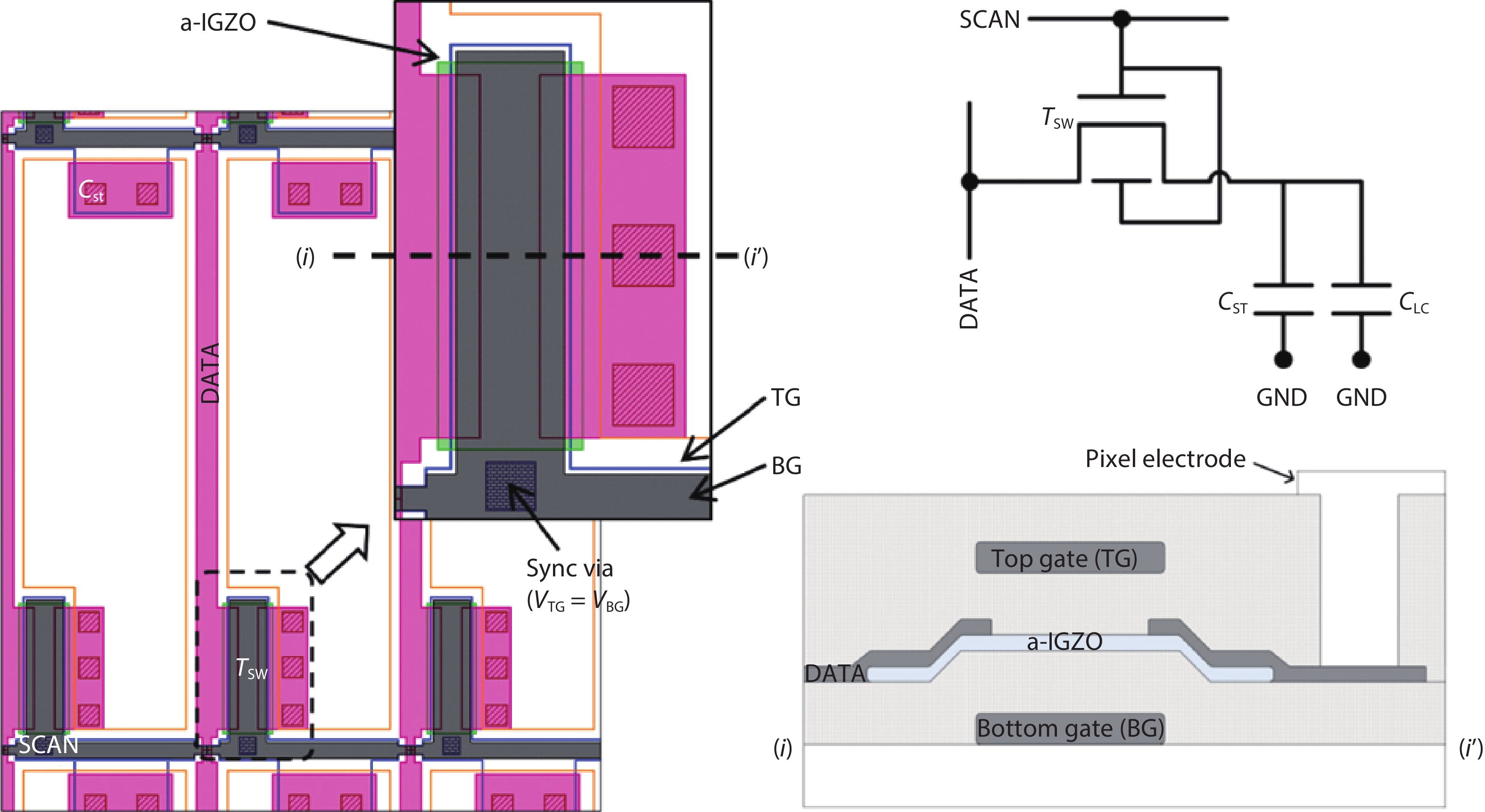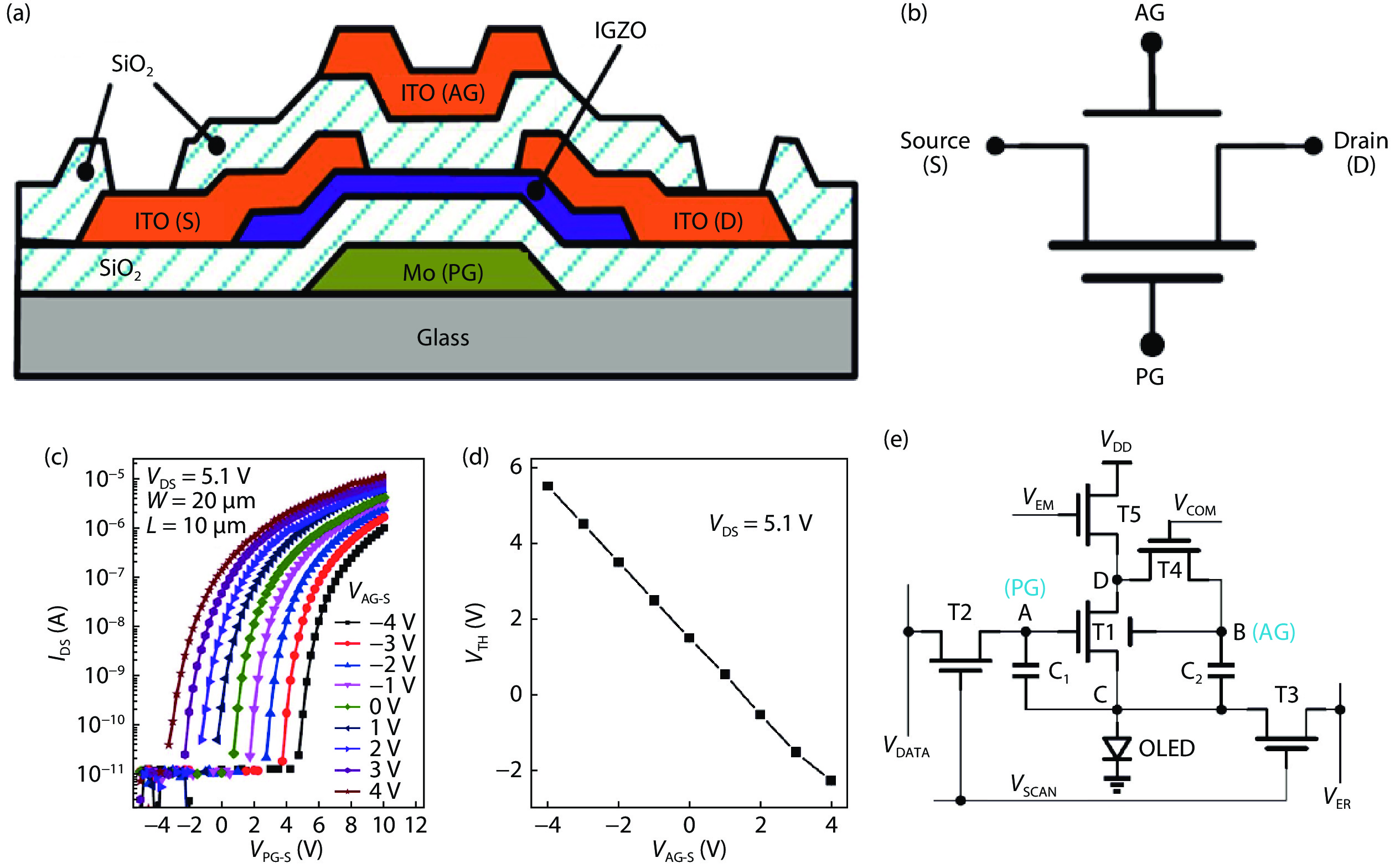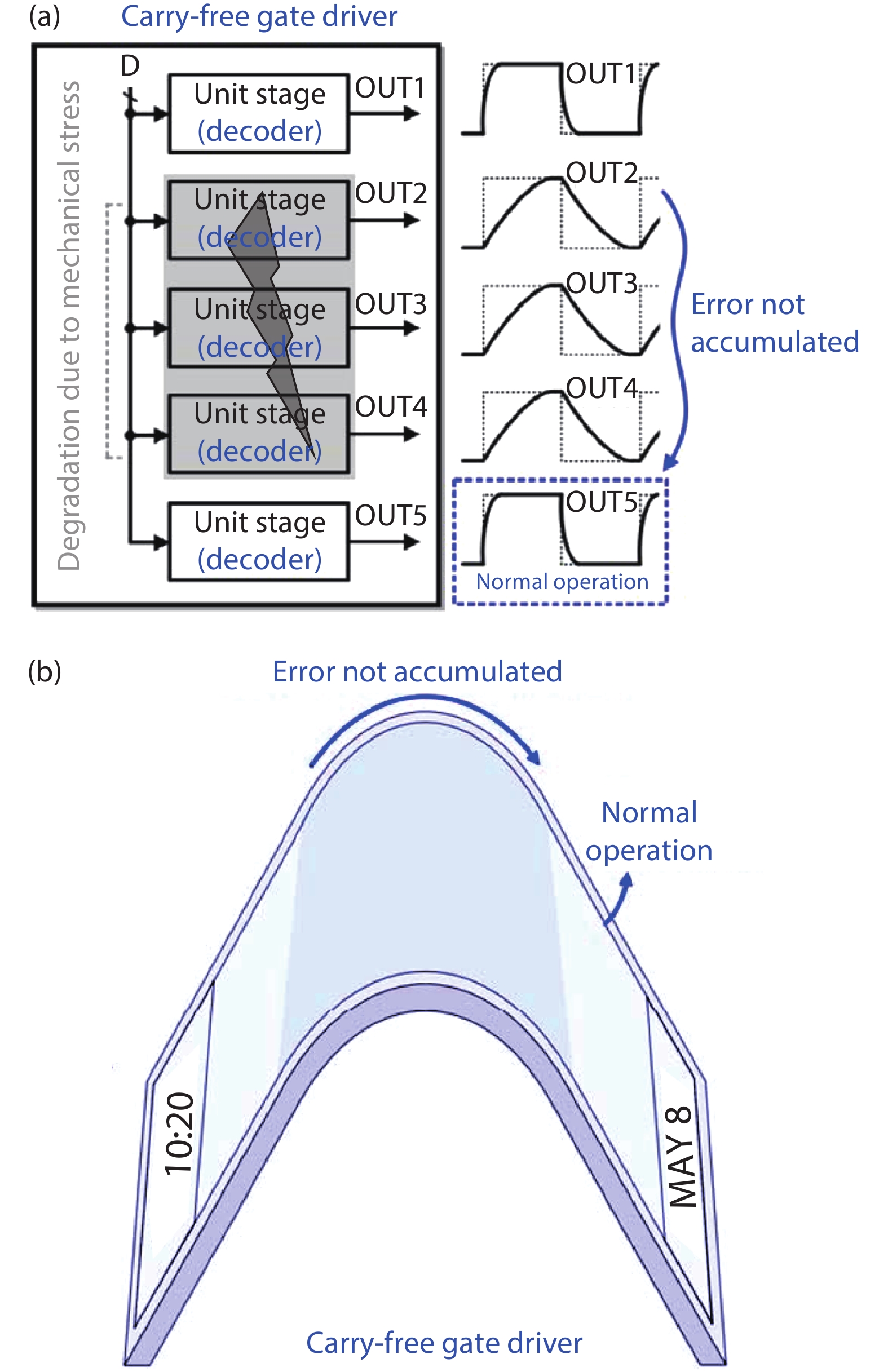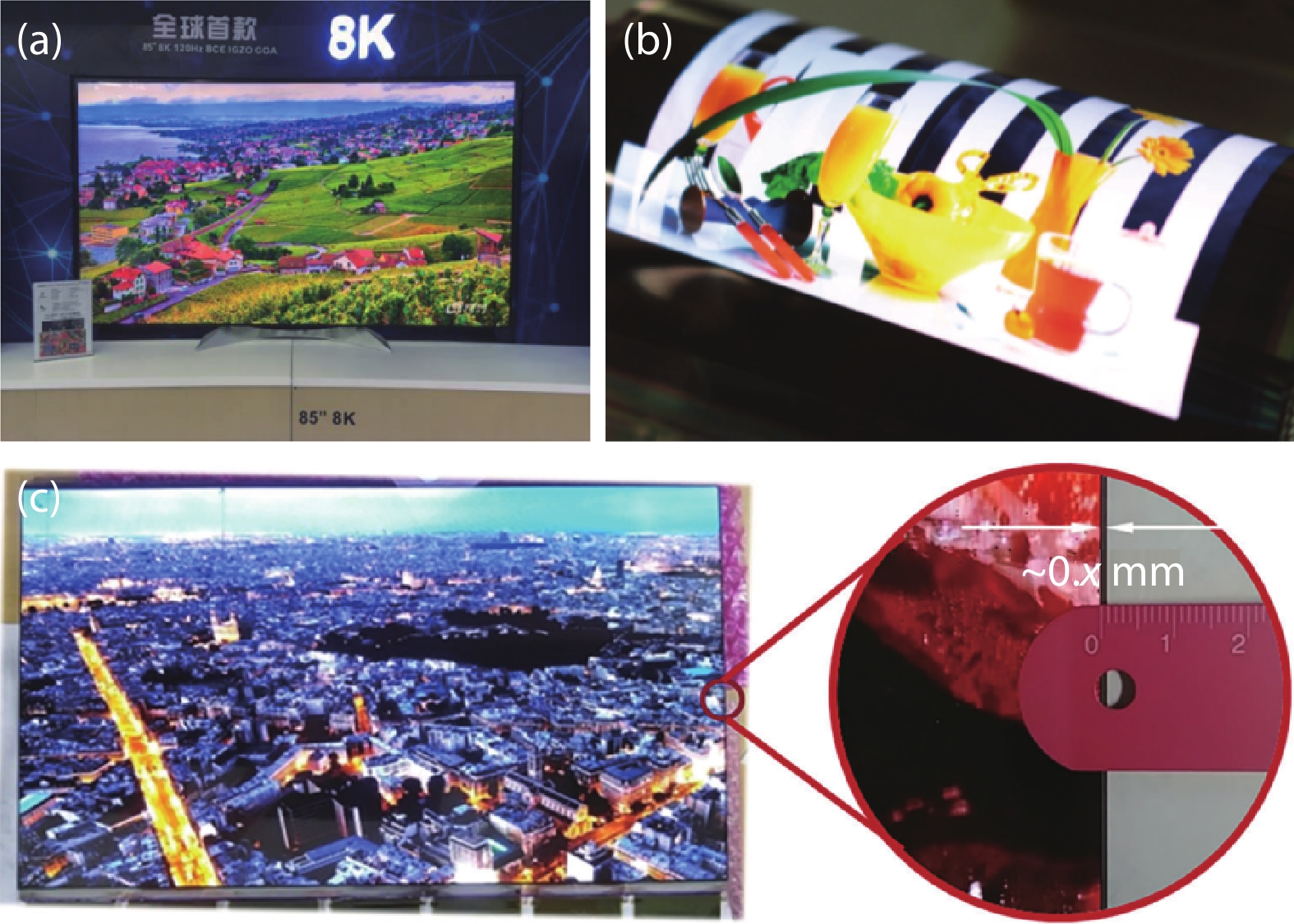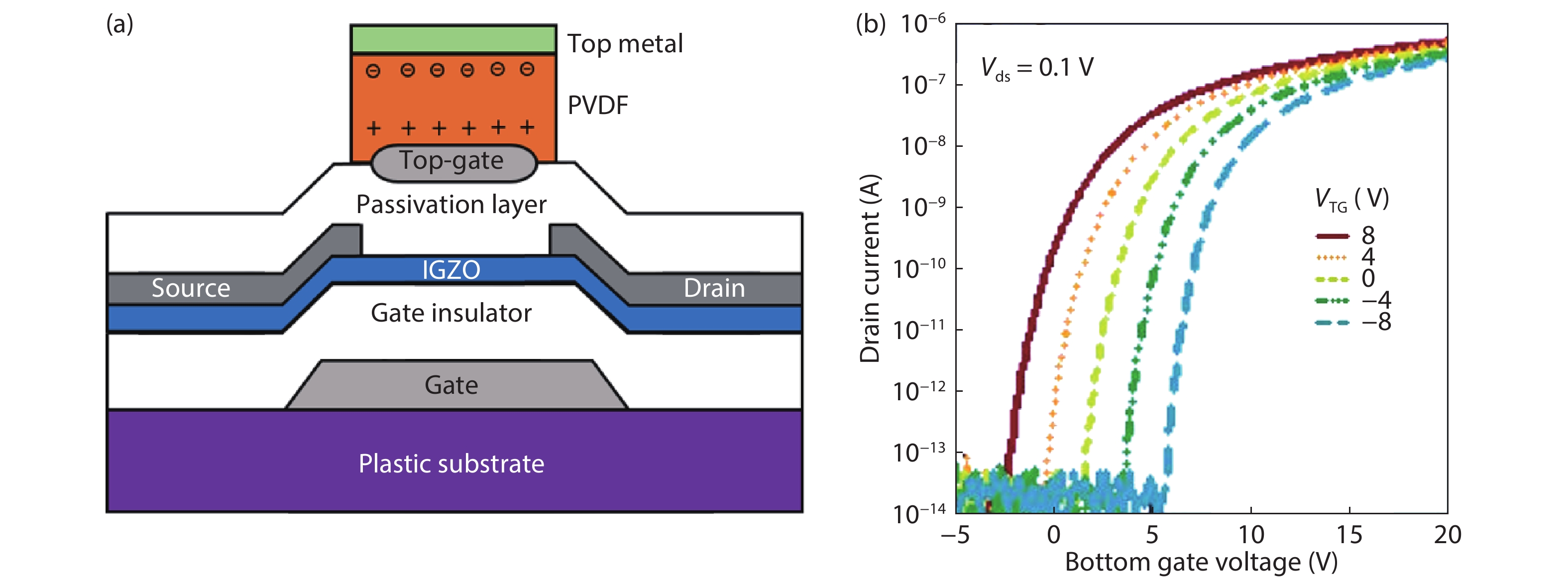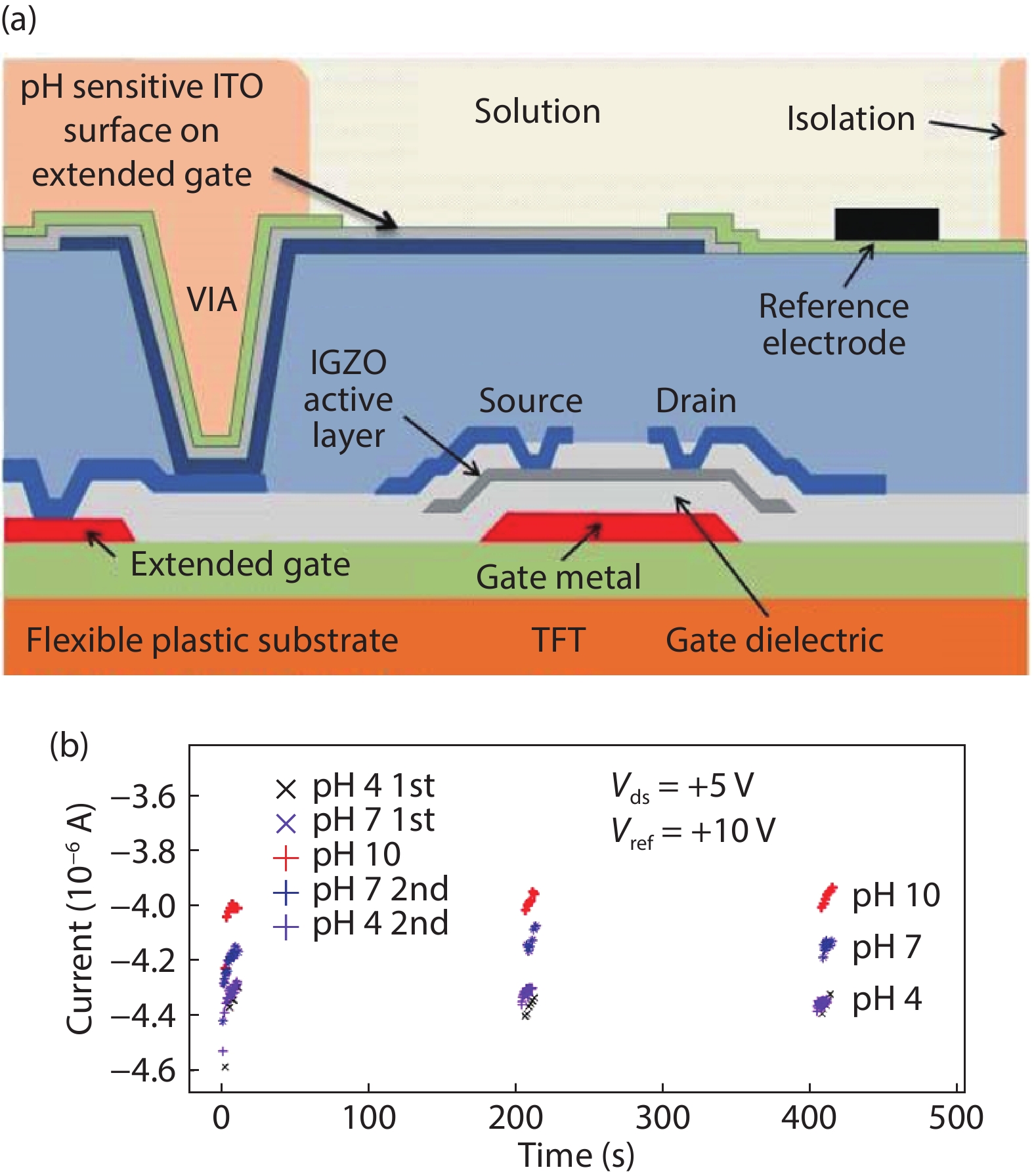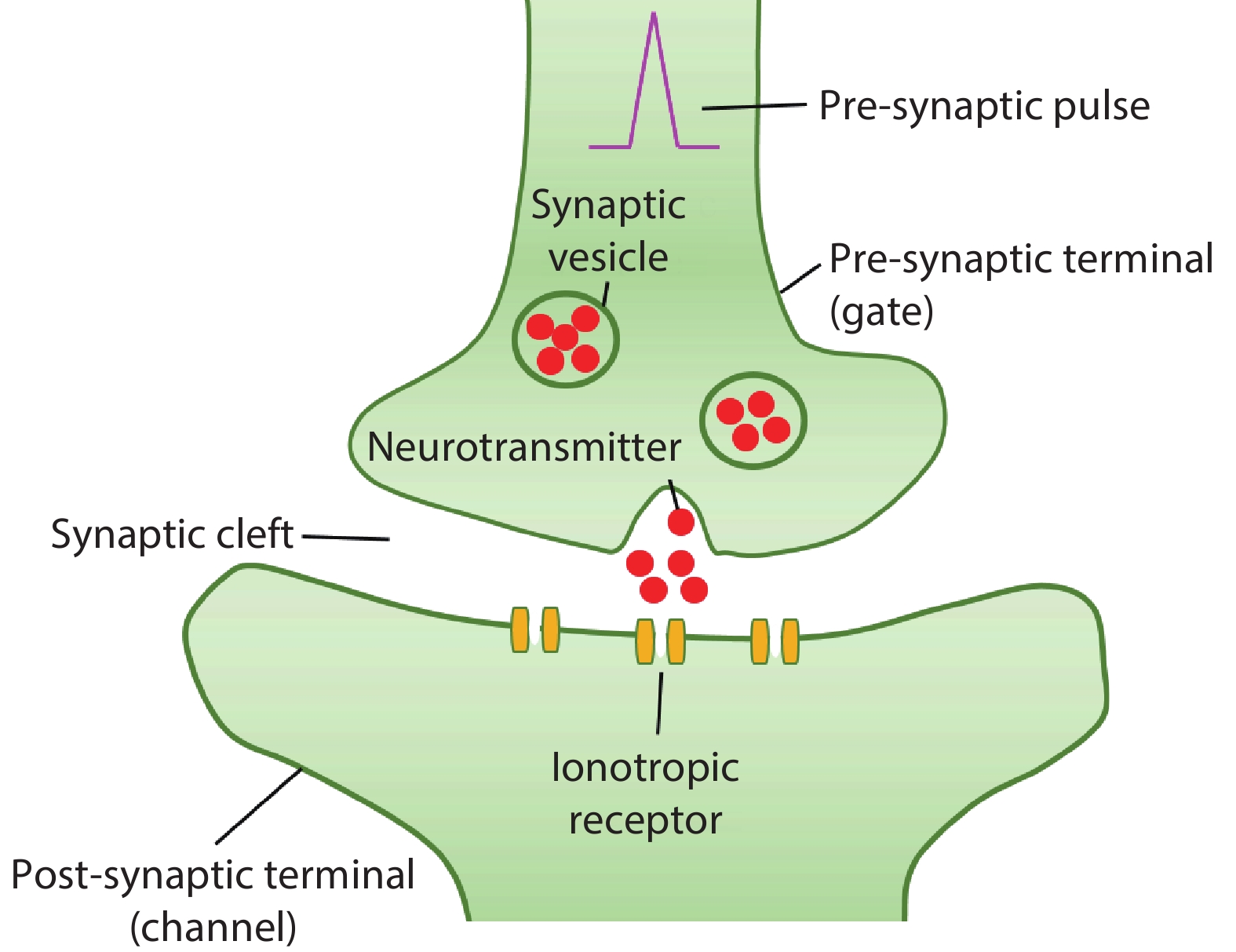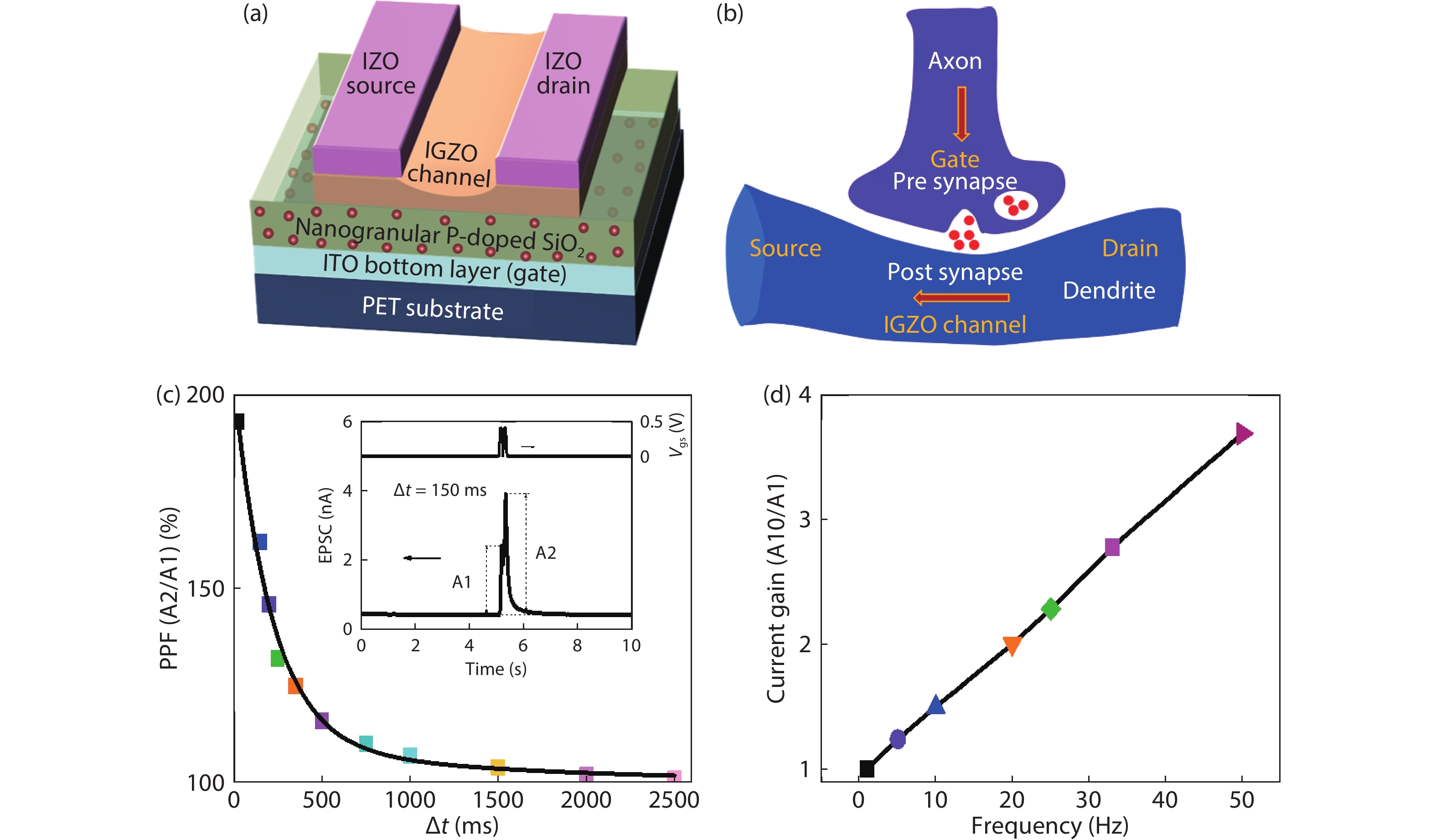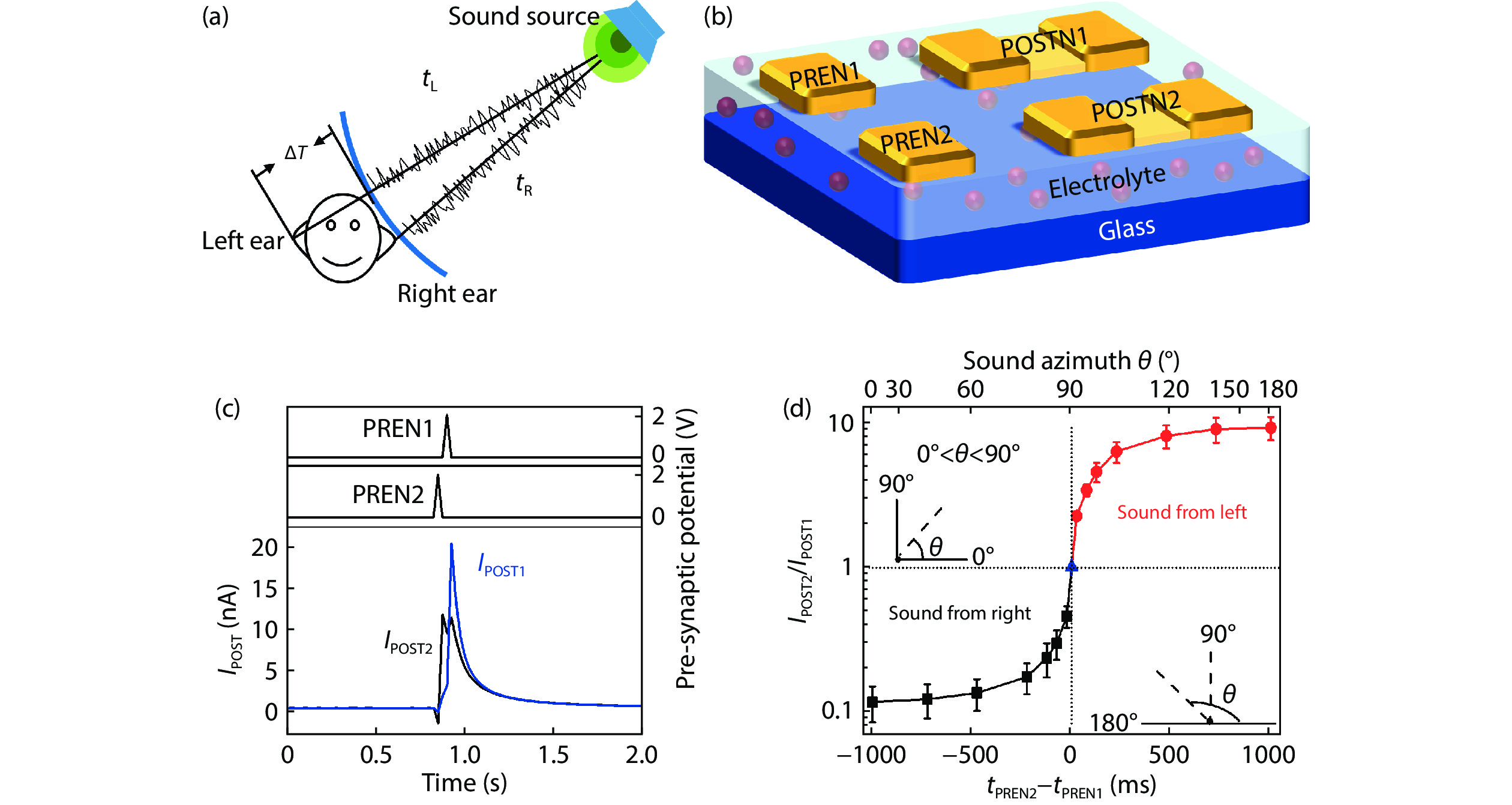| Citation: |
Ying Zhu, Yongli He, Shanshan Jiang, Li Zhu, Chunsheng Chen, Qing Wan. Indium–gallium–zinc–oxide thin-film transistors: Materials, devices, and applications[J]. Journal of Semiconductors, 2021, 42(3): 031101. doi: 10.1088/1674-4926/42/3/031101
****
Y Zhu, Y L He, S S Jiang, L Zhu, C S Chen, Q Wan, Indium–gallium–zinc–oxide thin-film transistors: Materials, devices, and applications[J]. J. Semicond., 2021, 42(3): 031101. doi: 10.1088/1674-4926/42/3/031101.
|
Indium–gallium–zinc–oxide thin-film transistors: Materials, devices, and applications
DOI: 10.1088/1674-4926/42/3/031101
More Information
-
Abstract
Since the invention of amorphous indium–gallium–zinc–oxide (IGZO) based thin-film transistors (TFTs) by Hideo Hosono in 2004, investigations on the topic of IGZO TFTs have been rapidly expanded thanks to their high electrical performance, large-area uniformity, and low processing temperature. This article reviews the recent progress and major trends in the field of IGZO-based TFTs. After a brief introduction of the history of IGZO and the main advantages of IGZO-based TFTs, an overview of IGZO materials and IGZO-based TFTs is given. In this part, IGZO material electron travelling orbitals and deposition methods are introduced, and the specific device structures and electrical performance are also presented. Afterwards, the recent advances of IGZO-based TFT applications are summarized, including flat panel display drivers, novel sensors, and emerging neuromorphic systems. In particular, the realization of flexible electronic systems is discussed. The last part of this review consists of the conclusions and gives an outlook over the field with a prediction for the future. -
References
[1] Kimizuka N, Mohri T. Spinel, YbFe2O4, and Yb2Fe3O7 types of structures for compounds in the In2O3 and Sc2O3–A2O3–BO systems [A: Fe, Ga, or Al; B: Mg, Mn, Fe, Ni, Cu, or Zn] at temperatures over 1000 °C. J Solid State Chem, 1985, 60, 382 doi: 10.1016/0022-4596(85)90290-7[2] Nomura K. Thin-film transistor fabricated in single-crystalline transparent oxide semiconductor. Science, 2003, 300, 1269 doi: 10.1126/science.1083212[3] Nomura K, Ohta H, Takagi A, et al. Room-temperature fabrication of transparent flexible thin-film transistors using amorphous oxide semiconductors. Nature, 2004, 432, 488 doi: 10.1038/nature03090[4] Arai T. Oxide-TFT technologies for next-generation AMOLED displays. J Soc Inf Disp, 2012, 20, 156 doi: 10.1889/JSID20.3.156[5] Lin C L, Lai P C, Lai P C, et al. Pixel circuit with parallel driving scheme for compensating luminance variation based on a-IGZO TFT for AMOLED displays. J Display Technol, 2016, 12, 1681 doi: 10.1109/JDT.2016.2616507[6] Kamiya T, Nomura K, Hosono H. Electronic structures above mobility edges in crystalline and amorphous In-Ga-Zn-O: Percolation conduction examined by analytical model. J Disp Technol, 2009, 5, 462 doi: 10.1109/JDT.2009.2022064[7] Wellenius P, Suresh A, Luo H, et al. An amorphous indium-gallium-zinc-oxide active matrix electroluminescent pixel. J Disp Technol, 2009, 5, 438 doi: 10.1109/JDT.2009.2024012[8] Ito M, Kon M, Ishizaki M, et al. A flexible active-matrix TFT array with amorphous oxide semiconductors for electronic paper. IDW/AD’05, 2005, 845[9] Lee H N, Kyung J, Kang S K, et al. 3.5 inch QCIF+ AM-OLED panel based on oxide TFT backplane. SID Symp Dig Tech Pap, 2007, 38, 1826 doi: 10.1889/1.2785691[10] Ito M, Kon M, Miyazaki C, et al. Amorphous oxide TFT and their applications in electrophoretic displays. Phys Status Solidi A, 2008, 205, 1885 doi: 10.1002/pssa.200778910[11] Jeong J K, Jeong J H, Choi J H, et al. 12.1-inch WXGA AMOLED display driven by indium-gallium-zinc oxide TFTs array. SID Symp Dig Tech Pap, 2008, 39, 1 doi: 10.1889/1.3069591[12] Lee J H, Kim D H, Yang D J, et al. World's largest (15-inch) XGA AMLCD panel using IGZO oxide TFT. SID Symp Dig Tech Pap, 2008, 39, 625 doi: 10.1889/1.3069740[13] Park J S, Kim T W, Stryakhilev D, et al. Flexible full color organic light-emitting diode display on polyimide plastic substrate driven by amorphous indium gallium zinc oxide thin-film transistors. Appl Phys Lett, 2009, 95, 013503 doi: 10.1063/1.3159832[14] Huang J J, Su C Y, Qiao X P, et al. Fabrication of 5.5-inch AMOLED panel using IGZO TFTs. SID Symp Dig Tech Pap, 2019, 50, 157[15] Choi S, Kim S, Jang J, et al. Oxygen content and bias influence on amorphous InGaZnO TFT-based temperature sensor performance. IEEE Electron Device Lett, 2019, 40, 1666 doi: 10.1109/LED.2019.2937157[16] Jeong H, Kong C S, Chang S W, et al. Temperature sensor made of amorphous indium–gallium–zinc oxide TFTs. IEEE Electron Device Lett, 2013, 34, 1569 doi: 10.1109/LED.2013.2286824[17] Kumar N, Kumar J, Panda S. Low temperature annealed amorphous indium gallium zinc oxide (a-IGZO) as a pH sensitive layer for applications in field effect based sensors. AIP Adv, 2015, 5, 067123 doi: 10.1063/1.4922440[18] Kumar N, Kumar J, Panda S. Back-channel electrolyte-gated a-IGZO dual-gate thin-film transistor for enhancement of pH sensitivity over Nernst limit. IEEE Electron Device Lett, 2016, 37, 500 doi: 10.1109/LED.2016.2536359[19] Smith J T, Shah S S, Goryll M, et al. Flexible ISFET biosensor using IGZO metal oxide TFTs and an ITO sensing layer. IEEE Sens J, 2014, 14, 937 doi: 10.1109/JSEN.2013.2295057[20] Geng D, Chen Y F, Mativenga M, et al. Touch sensor array with integrated drivers and comparator using a-IGZO TFTs. IEEE Electron Device Lett, 2017, 38, 391 doi: 10.1109/LED.2017.2661405[21] Tai Y H, Chiu H L, Chou L S. Active matrix touch sensor detecting time-constant change implemented by dual-gate IGZO TFTs. Solid-State Electron, 2012, 72, 67 doi: 10.1016/j.sse.2012.01.006[22] Chen X, Chen L L, Li T K, et al. Corrections to “highly sensitive flexible pressure sensor by the integration of microstructured PDMS film with a-IGZO TFTs”. IEEE Electron Device Lett, 2018, 39, 1262 doi: 10.1109/LED.2018.2854438[23] Smith J T, Couture A J, Stowell J R, et al. Optically seamless flexible electronic tiles for ultra large-area digital X-ray imaging. IEEE Trans Compon, Packag Manufact Technol, 2014, 4, 1109 doi: 10.1109/TCPMT.2014.2316477[24] Xiao P, Huang J H, Dong T, et al. X-ray photoelectron spectroscopy analysis of the effect of photoresist passivation on InGaZnO thin-film transistors. Appl Surf Sci, 2019, 471, 403 doi: 10.1016/j.apsusc.2018.11.211[25] Zhao C, Kanicki J. Amorphous In-Ga-Zn-O thin-film transistor active pixel sensor X-ray imager for digital breast tomosynthesis. Med Phys, 2014, 41, 091902 doi: 10.1118/1.4892382[26] Lee H, Kim J, Kim J, et al. Investigation of infrared photo-detection through subgap density-of-states in a-InGaZnO thin-film transistors. IEEE Electron Device Lett, 2017, 38, 584 doi: 10.1109/LED.2017.2686844[27] Yu J, Javaid K, Liang L, et al. High-performance visible-blind ultraviolet photodetector based on IGZO TFT coupled with p-n heterojunction. ACS Appl Mater Interfaces, 2018, 10, 8102 doi: 10.1021/acsami.7b16498[28] Tang H Y, Li Y T, Sokolovskij R, et al. Ultra-high sensitive NO2 gas sensor based on tunable polarity transport in CVD-WS2/IGZO p-n heterojunction. ACS Appl Mater Interfaces, 2019, 11, 40850 doi: 10.1021/acsami.9b13773[29] Yang D J, Whitfield G C, Cho N G, et al. Amorphous InGaZnO4 films: Gas sensor response and stability. Sens Actuators B, 2012, 171/172, 1166 doi: 10.1016/j.snb.2012.06.057[30] Zan H W, Li C H, Yeh C C, et al. Room-temperature-operated sensitive hybrid gas sensor based on amorphous indium gallium zinc oxide thin-film transistors. Appl Phys Lett, 2011, 98, 253503 doi: 10.1063/1.3601488[31] Nag M, Bhoolokam A, Smout S, et al. Circuits and AMOLED display with self-aligned a-IGZO TFTs on polyimide foil. J Soc Inf Disp, 2014, 22, 509 doi: 10.1002/jsid.281[32] Han G Q, Cao S G, Yang Q, et al. High-performance all-solution-processed flexible photodetector arrays based on ultrashort channel amorphous oxide semiconductor transistors. ACS Appl Mater Interfaces, 2018, 10, 40631 doi: 10.1021/acsami.8b14143[33] Honda W, Harada S, Ishida S, et al. High-performance, mechanically flexible, and vertically integrated 3D carbon nanotube and InGaZnO complementary circuits with a temperature sensor. Adv Mater, 2015, 27, 4674 doi: 10.1002/adma.201502116[34] Miura K, Ueda T, Nakano S, et al. Low-temperature-processed IGZO TFTs for flexible AMOLED with integrated gate driver circuits. SID Symp Dig Tech Pap, 2011, 42, 21 doi: 10.1889/1.3621277[35] Wan C J, Liu Y H, Zhu L Q, et al. Short-term synaptic plasticity regulation in solution-gated indium-gallium-zinc-oxide electric-double-layer transistors. ACS Appl Mater Interfaces, 2016, 8, 9762 doi: 10.1021/acsami.5b12726[36] He Y L, Nie S, Liu R, et al. Spatiotemporal information processing emulated by multiterminal neuro-transistor networks. Adv Mater, 2019, 31, 1900903 doi: 10.1002/adma.201900903[37] Liu Y H, Zhu L Q, Feng P, et al. Freestanding artificial synapses based on laterally proton-coupled transistors on chitosan membranes. Adv Mater, 2015, 27, 5599 doi: 10.1002/adma.201502719[38] Caughey D M, Thomas R E. Carrier mobilities in silicon empirically related to doping and field. Proc IEEE, 1967, 55, 2192 doi: 10.1109/PROC.1967.6123[39] Moore A R. Electron and hole drift mobility in amorphous silicon. Appl Phys Lett, 1977, 31, 762 doi: 10.1063/1.89539[40] Lee J M, Cho I T, Lee J H, et al. Bias-stress-induced stretched-exponential time dependence of threshold voltage shift in InGaZnO thin film transistors. Appl Phys Lett, 2008, 93, 093504 doi: 10.1063/1.2977865[41] Liao C W. Mobility impact on compensation performance of AMOLED pixel circuit using IGZO TFTs. J Semicond, 2019, 40, 022403 doi: 10.1088/1674-4926/40/2/022403[42] He Y L, Liu R, Jiang S S, et al. IGZO-based floating-gate synaptic transistors for neuromorphic computing. J Phys D, 2020, 53, 215106 doi: 10.1088/1361-6463/ab7bb4[43] He Y L, Nie S, Liu R, et al. Dual-functional long-term plasticity emulated in IGZO-based photoelectric neuromorphic transistors. IEEE Electron Device Lett, 2019, 40, 818 doi: 10.1109/LED.2019.2908727[44] Jiang J, Wan Q, Sun J, et al. Ultralow-voltage transparent electric-double-layer thin-film transistors processed at room-temperature. Appl Phys Lett, 2009, 95, 152114 doi: 10.1063/1.3251782[45] Wan X, Yang Y, Feng P, et al. Short-term plasticity and synaptic filtering emulated in electrolyte-gated IGZO transistors. IEEE Electron Device Lett, 2016, 37, 299 doi: 10.1109/LED.2016.2517080[46] Pierre A, Doris S E, Lujan R, et al. Monolithic integration of ion-selective organic electrochemical transistors with thin film transistors on flexible substrates. Adv Mater Technol, 2019, 4, 1800577 doi: 10.1002/admt.201800577[47] Meister T, Ishida K, Knobelspies S, et al. 5–31-Hz 188-μW light-sensing oscillator with two active inductors fully integrated on plastic. IEEE J Solid-State Circuits, 2019, 54, 2195 doi: 10.1109/JSSC.2019.2914405[48] Ma Q G, Wang H H, Zhou L F, et al. Robust gate driver on array based on amorphous IGZO thin-film transistor for large size high-resolution liquid crystal displays. IEEE J Electron Devices Soc, 2019, 7, 717 doi: 10.1109/JEDS.2019.2919677[49] Wu J, Shi J F, Dong C Y, et al. Effect of active layer deposition temperature on the performance of sputtered amorphous In–Ga–Zn–O thin film transistors. J Semicond, 2014, 35, 014003 doi: 10.1088/1674-4926/35/1/014003[50] Kim Y M, Kang H B, Kim G H, et al. Improvement in device performance of vertical thin-film transistors using atomic layer deposited IGZO channel and polyimide spacer. IEEE Electron Device Lett, 2017, 38, 1387 doi: 10.1109/LED.2017.2736000[51] Sheng J Z, Lee J H, Choi W H, et al. Atomic layer deposition for oxide semiconductor thin film transistors: Advances in research and development. J Vac Sci Technol A, 2018, 36, 060801 doi: 10.1116/1.5047237[52] Katsouras I, Frijters C, Poodt P, et al. Large-area spatial atomic layer deposition of amorphous oxide semiconductors at atmospheric pressure. J Soc Inf Disp, 2019, 27, 304 doi: 10.1002/jsid.783[53] Wu C H, Chang K M, Chen Y M, et al. Investigation of electrical characteristics on AP-PECVD fabricated amorphous IGZO TFTs with hydrogen plasma treatment. J Nanosci Nanotechnol, 2019, 19, 2306 doi: 10.1166/jnn.2019.15995[54] Takenaka K, Endo M, Hirayama H, et al. Low-temperature formation of high-mobility a-InGaZnOx films using plasma-enhanced reactive processes. Jpn J Appl Phys, 2019, 58, 090605 doi: 10.7567/1347-4065/ab219c[55] Wu C H, Chang K M, Chen Y M, et al. Study of in situ hydrogen plasma treatment on InGaZnO with atmospheric pressure-plasma enhanced chemical vapor deposition. J Nanosci Nanotechnol, 2019, 19, 2310 doi: 10.1166/jnn.2019.15997[56] Kim D J, Kim D L, Rim Y S, et al. Improved electrical performance of an oxide thin-film transistor having multistacked active layers using a solution process. ACS Appl Mater Interfaces, 2012, 4, 4001 doi: 10.1021/am3008278[57] Lilienfeld J E. Method and apparatus for controlling electric currents. USA Patent, US1745175, 1930[58] Weimer P. The TFT a new thin-film transistor. Proc IRE, 1962, 50, 1462 doi: 10.1109/JRPROC.1962.288190[59] Carcia P F, McLean R S, Reilly M H, et al. Transparent ZnO thin-film transistor fabricated by rf magnetron sputtering. Appl Phys Lett, 2003, 82, 1117 doi: 10.1063/1.1553997[60] Hoffman R L, Norris B J, Wager J F. ZnO-based transparent thin-film transistors. Appl Phys Lett, 2003, 82, 733 doi: 10.1063/1.1542677[61] Masuda S, Kitamura K, Okumura Y, et al. Transparent thin film transistors using ZnO as an active channel layer and their electrical properties. J Appl Phys, 2003, 93, 1624 doi: 10.1063/1.1534627[62] Nagata T, Hirasa S, Dozen Y, et al. A 2.78-in 1058-ppi ultra-high-resolution flexible OLED display using CAAC-IGZO FETs. SID Symp Dig Tech Pap, 2016, 47, 1052 doi: 10.1002/sdtp.10929[63] Troughton J, Atkinson D. Amorphous InGaZnO and metal oxide semiconductor devices: An overview and current status. J Mater Chem C, 2019, 7, 12388 doi: 10.1039/C9TC03933C[64] Mativenga M, Um J K, Kang D H, et al. Edge effects in bottom-gate inverted staggered thin-film transistors. IEEE Trans Electron Devices, 2012, 59, 2501 doi: 10.1109/TED.2012.2205258[65] Chang K J, Chen W T, Chang W C, et al. A-IGZO TFTs reliability improvement by dual gate structure. SID Symp Dig Tech Pap, 2015, 46, 1203 doi: 10.1002/sdtp.10353[66] Li X L, Geng D, Mativenga M, et al. High-speed dual-gate a-IGZO TFT-based circuits with top-gate offset structure. IEEE Electron Device Lett, 2014, 35, 461 doi: 10.1109/LED.2014.2305665[67] Lim H, Yin H X, Park J S, et al. Double gate GaInZnO thin film transistors. Appl Phys Lett, 2008, 93, 063505 doi: 10.1063/1.2967456[68] Munzenrieder N, Voser P, Petti L, et al. Flexible self-aligned double-gate IGZO TFT. IEEE Electron Device Lett, 2014, 35, 69 doi: 10.1109/LED.2013.2286319[69] Kim H R, Yang J H, Kim G H, et al. Flexible vertical-channel thin-film transistors using In-Ga-Zn-O active channel and polyimide spacer on poly(ethylene naphthalate) substrate. J Vac Sci Technol B, 2019, 37, 010602 doi: 10.1116/1.5082898[70] Liu Y, Zhou H L, Cheng R, et al. Highly flexible electronics from scalable vertical thin film transistors. Nano Lett, 2014, 14, 1413 doi: 10.1021/nl404484s[71] Yeom H I, Moon G, Nam Y, et al. Oxide vertical TFTs for the application to the ultra high resolution display. SID Symp Dig Tech Pap, 2016, 47, 820 doi: 10.1002/sdtp.10799[72] Du P F, Feng P, Wan X, et al. Amorphous InGaZnO4 neuron transistors with temporal and spatial summation function. Chin Phys Lett, 2017, 34, 058502 doi: 10.1088/0256-307X/34/5/058502[73] Kim H E, Furuta M, Yoon S M. A facile doping process of the organic inter-layer dielectric for self-aligned coplanar In-Ga-Zn-O thin-film transistors. IEEE Electron Device Lett, 2020, 41, 393 doi: 10.1109/LED.2020.2964270[74] Zhang Y Q, Yang H, Peng H, et al. Self-aligned top-gate amorphous InGaZnO TFTs with plasma enhanced chemical vapor deposited sub-10 nm SiO2 gate dielectric for low-voltage applications. IEEE Electron Device Lett, 2019, 40, 1459 doi: 10.1109/LED.2019.2931358[75] Sato A, Abe K, Hayashi R, et al. Amorphous In–Ga–Zn–O coplanar homojunction thin-film transistor. Appl Phys Lett, 2009, 94, 133502 doi: 10.1063/1.3112566[76] Su L Y, Lin H K, Hung C C, et al. Role ofHfO2/SiO2 gate dielectric on the reduction of low-frequent noise and the enhancement of a-IGZO TFT electrical performance. J Disp Technol, 2012, 8, 695 doi: 10.1109/JDT.2012.2217728[77] Yamamoto T, Takei T, Nakajima Y, et al. Simple transfer technology for fabrication of TFT backplane for flexible displays. IEEE Trans Ind Appl, 2012, 48, 1662 doi: 10.1109/TIA.2012.2209170[78] Hyung G W, Park J, Wang J X, et al. Amorphous indium gallium zinc oxide thin-film transistors with a low-temperature polymeric gate dielectric on a flexible substrate. Jpn J Appl Phys, 2013, 52, 071102 doi: 10.7567/JJAP.52.071102[79] Zhu L Q, Wan C J, Guo L Q, et al. Artificial synapse network on inorganic proton conductor for neuromorphic systems. Nat Commun, 2014, 5, 3158 doi: 10.1038/ncomms4158[80] Yang Y, He Y L, Nie S, et al. Light stimulated IGZO-based electric-double-layer transistors for photoelectric neuromorphic devices. IEEE Electron Device Lett, 2018, 39, 897 doi: 10.1109/LED.2018.2824339[81] Beom K, Yang P, Park D, et al. Single- and double-gate synaptic transistor with TaOx gate insulator and IGZO channel layer. Nanotechnology, 2019, 30, 025203 doi: 10.1088/1361-6528/aae8d2[82] Chen T C, Kuo Y, Chang T C, et al. Stability of double gate amorphous In–Ga–Zn–O thin-film transistors with various top gate designs. Jpn J Appl Phys, 2017, 56, 120303 doi: 10.7567/JJAP.56.120303[83] Cho W J, Ahn M J. Bias stress instability of double-gate a-IGZO TFTs on polyimide substrate. J Korean Phys Soc, 2017, 71, 325 doi: 10.3938/jkps.71.325[84] He X, Wang L Y, Xiao X, et al. Implementation of fully self-aligned homojunction double-gate a-IGZO TFTs. IEEE Electron Device Lett, 2014, 35, 927 doi: 10.1109/LED.2014.2336232[85] Nathan A, Lee S, Jeon S, et al. Amorphous oxide semiconductor TFTs for displaysand imaging. J Disp Technol, 2014, 10, 917 doi: 10.1109/JDT.2013.2292580[86] Kuzum D, Yu S M, Philip Wong H S. Synaptic electronics: Materials, devices and applications. Nanotechnology, 2013, 24, 382001 doi: 10.1088/0957-4484/24/38/382001[87] Mativenga M, Choi M H, Choi J W, et al. Transparent flexible circuits based on amorphous-indium–gallium–zinc–oxide thin-film transistors. IEEE Electron Device Lett, 2011, 32, 170 doi: 10.1109/LED.2010.2093504[88] Cantarella G, Ishida K, Petti L, et al. Flexible In–Ga–Zn–O-based circuits with two and three metal layers: Simulation and fabrication study. IEEE Electron Device Lett, 2016, 37, 1582 doi: 10.1109/LED.2016.2619738[89] Lee S, Jeon S, Chaji R, et al. Transparent semiconducting oxide technology for touch free interactive flexible displays. Proc IEEE, 2015, 103, 644 doi: 10.1109/JPROC.2015.2405767[90] Hsieh H H, Lu H H, Ting H C, et al. Development of IGZO TFTs and their applications to next-generation flat-panel displays. J Inf Disp, 2010, 11, 160 doi: 10.1080/15980316.2010.9665845[91] Baek G, Kanicki J. Modeling of current: Voltage characteristics for double-gate a-IGZO TFTs and its application to AMLCDs. J Soc Inf Display, 2012, 20, 237 doi: 10.1889/JSID20.5.237[92] Gong N, Park C, Lee J, et al. Implementation of 240Hz 55-inch ultra definition LCD driven by a-IGZO semiconductor TFT with copper signal lines. SID Symp Dig Tech Pap, 2012, 43, 784 doi: 10.1002/j.2168-0159.2012.tb05902.x[93] Lin C L, Chang W Y, Hung C C. Compensating pixel circuit driving AMOLED display with a-IGZO TFTs. IEEE Electron Device Lett, 2013, 34, 1166 doi: 10.1109/LED.2013.2271783[94] Kim D, Kim Y, Lee S, et al. High resolution a-IGZO TFT pixel circuit for compensating threshold voltage shifts and OLED degradations. IEEE J Electron Devices Soc, 2017, 5, 372 doi: 10.1109/JEDS.2017.2716368[95] Lai P C, Lin C L, Kanicki J. Novel top-anode OLED/a-IGZO TFTs pixel circuit for 8K4K AM-OLEDs. IEEE Trans Electron Devices, 2019, 66, 436 doi: 10.1109/TED.2018.2877945[96] Liao C, Deng W, Song D, et al. Mirrored OLED pixel circuit for threshold voltage and mobility compensation with IGZO TFTs. Microelectron J, 2015, 46, 923 doi: 10.1016/j.mejo.2015.08.003[97] Lin C L, Chen F H, Hung C C, et al. New a-IGZO pixel circuit composed of three transistors and one capacitor for use in high-speed-scan AMOLED displays. J Disp Technol, 2015, 11, 1031 doi: 10.1109/JDT.2015.2494064[98] Mativenga M, Ha S H, Geng D, et al. Infinite output resistance of corbino thin-film transistors with an amorphous-InGaZnO active layer for large-area AMOLED displays. IEEE Trans Electron Devices, 2014, 61, 3199 doi: 10.1109/TED.2014.2338306[99] Shimazoe K, Koyama A, Takahashi H, et al. Prototype of IGZO-TFT preamplifier and analog counter for pixel detector. J Instrum, 2017, 12, C02045 doi: 10.1088/1748-0221/12/02/C02045[100] Shin W S, Ahn H A, Na J S, et al. A driving method of pixel circuit using a-IGZO TFT for suppression of threshold voltage shift in AMLED displays. IEEE Electron Device Lett, 2017, 38, 760 doi: 10.1109/LED.2017.2699669[101] Wang C C, Hu Z J, He X, et al. One gate diode-connected dual-gate a-IGZO TFT driven pixel circuit for active matrix organic light-emitting diode displays. IEEE Trans Electron Devices, 2016, 63, 3800 doi: 10.1109/TED.2016.2587718[102] Yang J Y, Jung S H, Woo C S, et al. A short-channel TFT of amorphous In–Ga–Zn–O semiconductor pixel structure with advanced five-mask process. IEEE Electron Device Lett, 2014, 35, 1043 doi: 10.1109/LED.2014.2349902[103] Zhou L, Xu M, Xia X H, et al. Power consumption model for AMOLED display panel based on 2T-1C pixel circuit. J Display Technol, 2016, 12, 1064 doi: 10.1109/JDT.2016.2583665[104] Hara Y, Kikuchi T, Kitagawa H, et al. IGZO-TFT technology for large-screen 8K display. J Soc Inf Disp, 2018, 26, 169 doi: 10.1002/jsid.648[105] Lin C L, Chen P S, Lai P C, et al. Novel pixel circuit with compensation for normally-off/on a-IGZO TFTs and OLED luminance degradation. J Disp Technol, 2016, 12, 1664 doi: 10.1109/JDT.2016.2615658[106] Tai Y H, Chou L S, Chiu H L, et al. Three-transistor AMOLED pixel circuit with threshold voltage compensation function using dual-gate IGZO TFT. IEEE Electron Device Lett, 2012, 33, 393 doi: 10.1109/LED.2011.2179282[107] Jeon C H, Um J G, Mativenga M, et al. Fast threshold voltage compensation AMOLED pixel circuit using secondary gate effect of dual gate a-IGZO TFTs. IEEE Electron Device Lett, 2016, 37, 1450 doi: 10.1109/LED.2016.2613400[108] Bagheri M, Cheng X, Zhang J H, et al. Threshold voltage compensation error in voltage programmed AMOLED displays. J Disp Technol, 2016, 12, 658 doi: 10.1109/JDT.2016.2530784[109] Lim W, Jang J H, Kim S H, et al. High performance indium gallium zinc oxide thin film transistors fabricated on polyethylene terephthalate substrates. Appl Phys Lett, 2008, 93, 082102 doi: 10.1063/1.2975959[110] Fortunato E, Correia N, Barquinha P, et al. High-performance flexible hybrid field-effect transistors based on cellulose fiber paper. IEEE Electron Device Lett, 2008, 29, 988 doi: 10.1109/LED.2008.2001549[111] Lee G J, Kim J, Kim J H, et al. High performance, transparent a-IGZO TFTs on a flexible thin glass substrate. Semicond Sci Technol, 2014, 29, 035003 doi: 10.1088/0268-1242/29/3/035003[112] Münzenrieder N, Zysset C, Petti L, et al. Flexible double gate a-IGZO TFT fabricated on free standing polyimide foil. Solid-State Electron, 2013, 84, 198 doi: 10.1016/j.sse.2013.02.025[113] Lim W, Douglas E A, Norton D P, et al. Low-voltage indium gallium zinc oxide thin film transistors on paper substrates. Appl Phys Lett, 2010, 96, 053510 doi: 10.1063/1.3309753[114] Kim Y C, Lee S J, Oh I K, et al. Bending stability of flexible amorphous IGZO thin film transistors with transparent IZO/Ag/IZO oxide-metal-oxide electrodes. J Alloy Compd, 2016, 688, 1108 doi: 10.1016/j.jallcom.2016.07.169[115] Munzenrieder N, Cherenack K H, Troster G. The effects of mechanical bending and illumination on the performance of flexible IGZO TFTs. IEEE Trans Electron Devices, 2011, 58, 2041 doi: 10.1109/TED.2011.2143416[116] Nakano S, Saito N, Miura K, et al. Highly reliable a-IGZO TFTs on a plastic substrate for flexible AMOLED displays. J Soc Inf Disp, 2012, 20, 493 doi: 10.1002/jsid.111[117] Kim J S, Byun J W, Jang J H, et al. A high-reliability carry-free gate driver for flexible displays using a-IGZO TFTs. IEEE Trans Electron Devices, 2018, 65, 3269 doi: 10.1109/TED.2018.2843180[118] Kim D S, Kwon O K. A small-area and low-power scan driver using a coplanar a-IGZO thin-film transistor with a dual-gate for liquid crystal displays. IEEE Electron Device Lett, 2017, 38, 195 doi: 10.1109/LED.2016.2638832[119] Yamaguchi H, Ueda T, Miura K, et al. 11.7-inch flexible AMOLED display driven by a-IGZO TFTs on plastic substrate. SID Symp Dig Tech Pap, 2012, 43, 1002 doi: 10.1002/j.2168-0159.2012.tb05961.x[120] Yoo W B, Ha C, Kwon J, et al. Flexible a-IGZO TFT for large sized OLED TV. SID Symp Dig Tech Pap, 2018, 49, 714 doi: 10.1002/sdtp.12377[121] Zhao Y C, Zhao F, Chang C, et al. The world's first prototype of 85-inch 8K4K 120Hz LCD with BCE-IGZO structure and GOA design. SID Symp Dig Tech Pap, 2018, 49, 330 doi: 10.1002/sdtp.12717[122] Kim K M, Han I, Noh S, et al. Bezel free design of organic light emitting diode display via a-InGaZnO gate driver circuit integration within active array. J Soc Inf Disp, 2019, 27, 514 doi: 10.1002/jsid.827[123] Liu N, Zhu L Q, Feng P, et al. Flexible sensory platform based on oxide-based neuromorphic transistors. Sci Rep, 2015, 5, 18082 doi: 10.1038/srep18082[124] Shah S, Smith J, Stowell J, et al. Biosensing platform on a flexible substrate. Sens Actuators B, 2015, 210, 197 doi: 10.1016/j.snb.2014.12.075[125] Cai G S, Yang P, Wang X Z, et al. Investigation of pH sensor based on liquid-solid dual-gated IGZO thin-film transistor. Mater Res Express, 2019, 6, 096305 doi: 10.1088/2053-1591/ab2c93[126] Pavlidis S, Getz P, Hagen J, et al. Investigating thin film passivations for IGZO dual gate pH sensors fabrication at low temperature. 2015 18th International Conference on Solid-State Sensors, Actuators and Microsystems, 2015, 1334[127] Kimura M, Hasegawa T, Ide K, et al. Light irradiation history sensor using amorphous In-Ga-Zn-O thin-film transistor exposed to ozone annealing. IEEE Electron Device Lett, 2012, 33, 384 doi: 10.1109/LED.2011.2179111[128] Liu P T, Ruan D B, Yeh X Y, et al. Highly responsive blue light sensor with amorphous indium-zinc-oxide thin-film transistor based architecture. Sci Rep, 2018, 8, 8153 doi: 10.1038/s41598-018-26580-5[129] Pei Z, Lai H C, Wang J Y, et al. High-responsivity and high-sensitivity graphene dots/a-IGZO thin-film phototransistor. IEEE Electron Device Lett, 2015, 36, 44 doi: 10.1109/LED.2014.2368773[130] Yu J, Shin S W, Lee K H, et al. Visible-light phototransistors based on InGaZnO and silver nanoparticles. J Vac Sci Technol B, 2015, 33, 061211 doi: 10.1116/1.4936113[131] Zan H W, Chen W T, Hsueh H W, et al. Amorphous indium-gallium-zinc-oxide visible-light phototransistor with a polymeric light absorption layer. Appl Phys Lett, 2010, 97, 203506 doi: 10.1063/1.3517506[132] Tressler J F, Alkoy S, Newnham R E. Piezoelectric sensors and sensor materials. J Electrocera, 1998, 2, 257 doi: 10.1023/A:1009926623551[133] Geng D, Han S Y, Seo H, et al. Piezoelectric pressure sensing device using top-gate effect of dual-gate a-IGZO TFT. IEEE Sensor J, 2017, 17, 585 doi: 10.1109/JSEN.2016.2639525[134] Maity D, Halder S, Roy P. High pH sensing properties of a new schiff-base compound. ChemistrySelect, 2018, 3, 440 doi: 10.1002/slct.201702307[135] Ahn M J, Lim C M, Cho W J. Highly sensitive ion-sensitive field-effect transistor sensor using fully transparent amorphous In–Ga–Zn–O thin-film transistors. Semicond Sci Technol, 2017, 32, 035003 doi: 10.1088/1361-6641/aa5138[136] Pyo J Y, Cho W J. High-performance SEGISFET pH Sensor using the structure of double-gate a-IGZO TFTs with engineered gate oxides. Semicond Sci Technol, 2017, 32, 035015 doi: 10.1088/1361-6641/aa584b[137] Kim K S, Ahn C H, Jung S H, et al. Toward adequate operation of amorphous oxide thin-film transistors for low-concentration gas detection. ACS Appl Mater Interfaces, 2018, 10, 10185 doi: 10.1021/acsami.7b18657[138] Lee Y T, Lee J, Hwang H, et al. Novel hydrogen gas sensing by palladium electrode on dielectric capacitor coupled with an amorphous InGaZnO thin-film transistor. Sens Actuators B, 2015, 209, 490 doi: 10.1016/j.snb.2014.12.005[139] Li B C, Lai P T, Tang W M. Hydrogen sensors based on TFT's with catalytic source/drain electrodes: IGZO vs. pentacene. IEEE Electron Device Lett, 2018, 1 doi: 10.1109/LED.2018.2865743[140] Knobelspies S, Bierer B, Daus A, et al. Photo-induced room-temperature gas sensing with a-IGZO based thin-film transistors fabricated on flexible plastic foil. Sensors, 2018, 18, E358 doi: 10.3390/s18020358[141] Tripathi A K, Myny K, Hou B, et al. Electrical characterization of flexible InGaZnO transistors and 8-b transponder chip down to a bending radius of 2 mm. IEEE Trans Electron Devices, 2015, 62, 4063 doi: 10.1109/TED.2015.2494694[142] Chen Y F, Geng D, Lin T D, et al. Full-swing clock generating circuits on plastic using a-IGZO dual-gate TFTs with pseudo-CMOS and bootstrapping. IEEE Electron Device Lett, 2016, 37, 882 doi: 10.1109/LED.2016.2571321[143] Zheng J W, Han S J, Li M M, et al. A full-swing inverter based on IGZO TFTs for flexible circuits. SID Symp Dig Tech Pap, 2018, 49, 709 doi: 10.1002/sdtp.12822[144] Bahubalindruni P G, Tiwari B, Pereira M, et al. Rail-to-rail timing signals generation using InGaZnO TFTs for flexible X-ray detector. IEEE J Electron Devices Soc, 2020, 8, 157 doi: 10.1109/JEDS.2020.2971277[145] Jeon S, Park S, Song I, et al. 180nm gate length amorphous InGaZnO thin film transistor for high density image sensor applications. IEEE International Electron Devices Meeting, 2010[146] Chang T H, Chiu C J, Chang S J, et al. Amorphous InGaZnO ultraviolet phototransistors with double-stack Ga2O3/SiO2 dielectric. Appl Phys Lett, 2013, 102, 221104 doi: 10.1063/1.4808164[147] Vijjapu M T, Surya S G, Yuvaraja S, et al. Fully integrated indium gallium zinc oxide NO2 gas detector. ACS Sens, 2020, 5, 984 doi: 10.1021/acssensors.9b02318[148] Park I J, Jeong C Y, Cho I T, et al. Fabrication of amorphous InGaZnO thin-film transistor-driven flexible thermal and pressure sensors. Semicond Sci Technol, 2012, 27, 105019 doi: 10.1088/0268-1242/27/10/105019[149] Zhang Z H, Chen L L, Yang X, et al. Enhanced flexible piezoelectric sensor by the integration of P(VDF-TrFE)/AgNWs film with a-IGZO TFT. IEEE Electron Device Lett, 2018, 40, 111 doi: 10.1109/LED.2018.2881983[150] Lujan R A, Street R A. Flexible X-ray detector array fabricated with oxide thin-film transistors. IEEE Electron Device Lett, 2012, 33, 688 doi: 10.1109/LED.2012.2188825[151] Machens C K. Building the human brain. Science, 2012, 338, 1156 doi: 10.1126/science.1231865[152] Merolla P A, Arthur J V, Alvarez-Icaza R, et al. A million spiking-neuron integrated circuit with a scalable communication network and interface. Science, 2014, 345, 668 doi: 10.1126/science.1254642[153] Zidan M A, Strachan J P, Lu W D. The future of electronics based on memristive systems. Nat Electron, 2018, 1, 22 doi: 10.1038/s41928-017-0006-8[154] Xia Q, Yang J J. Memristive crossbar arrays for brain-inspired computing. Nat Mater, 2019, 18, 309 doi: 10.1038/s41563-019-0291-x[155] Wang Z R, Li C, Song W H, et al. Reinforcement learning with analogue memristor arrays. Nat Electron, 2019, 2, 115 doi: 10.1038/s41928-019-0221-6[156] Tan Z H, Yang R, Terabe K, et al. Synaptic metaplasticity realized in oxide memristive devices. Adv Mater, 2016, 28, 377 doi: 10.1002/adma.201503575[157] Wang J B, Li Y X, Yin C Q, et al. Long-term depression mimicked in an IGZO-based synaptic transistor. IEEE Electron Device Lett, 2017, 38, 191 doi: 10.1109/LED.2016.2639539[158] He Y L, Nie S, Liu R, et al. Indium–gallium–zinc–oxide Schottky synaptic transistors for silent synapse conversion emulation. IEEE Electron Device Lett, 2019, 40, 139 doi: 10.1109/LED.2018.2883442[159] Wan C J, Zhu L Q, Liu Y H, et al. Proton-conducting graphene oxide-coupled neuron transistors for brain-inspired cognitive systems. Adv Mater, 2016, 28, 3557 doi: 10.1002/adma.201505898[160] Wan X, Feng P, Wu G D, et al. Simulation of laterally coupled InGaZnO4-based electric-double-layer transistors for synaptic electronics. IEEE Electron Device Lett, 2015, 36, 204 doi: 10.1109/LED.2015.2388952[161] Zhou J M, Liu N, Zhu L Q, et al. Energy-efficient artificial synapses based on flexible IGZO electric-double-layer transistors. IEEE Electron Device Lett, 2015, 36, 198 doi: 10.1109/LED.2014.2381631[162] Du H W, Lin X, Xu Z M, et al. Electric double-layer transistors: A review of recent progress. J Mater Sci, 2015, 50, 5641 doi: 10.1007/s10853-015-9121-y[163] He Y L, Wan Q. Multi-terminal oxide-based electric-double-layer thin-film transistors for neuromorphic systems. ECS Trans, 2018, 86, 177 doi: 10.1149/08611.0177ecst -
Proportional views





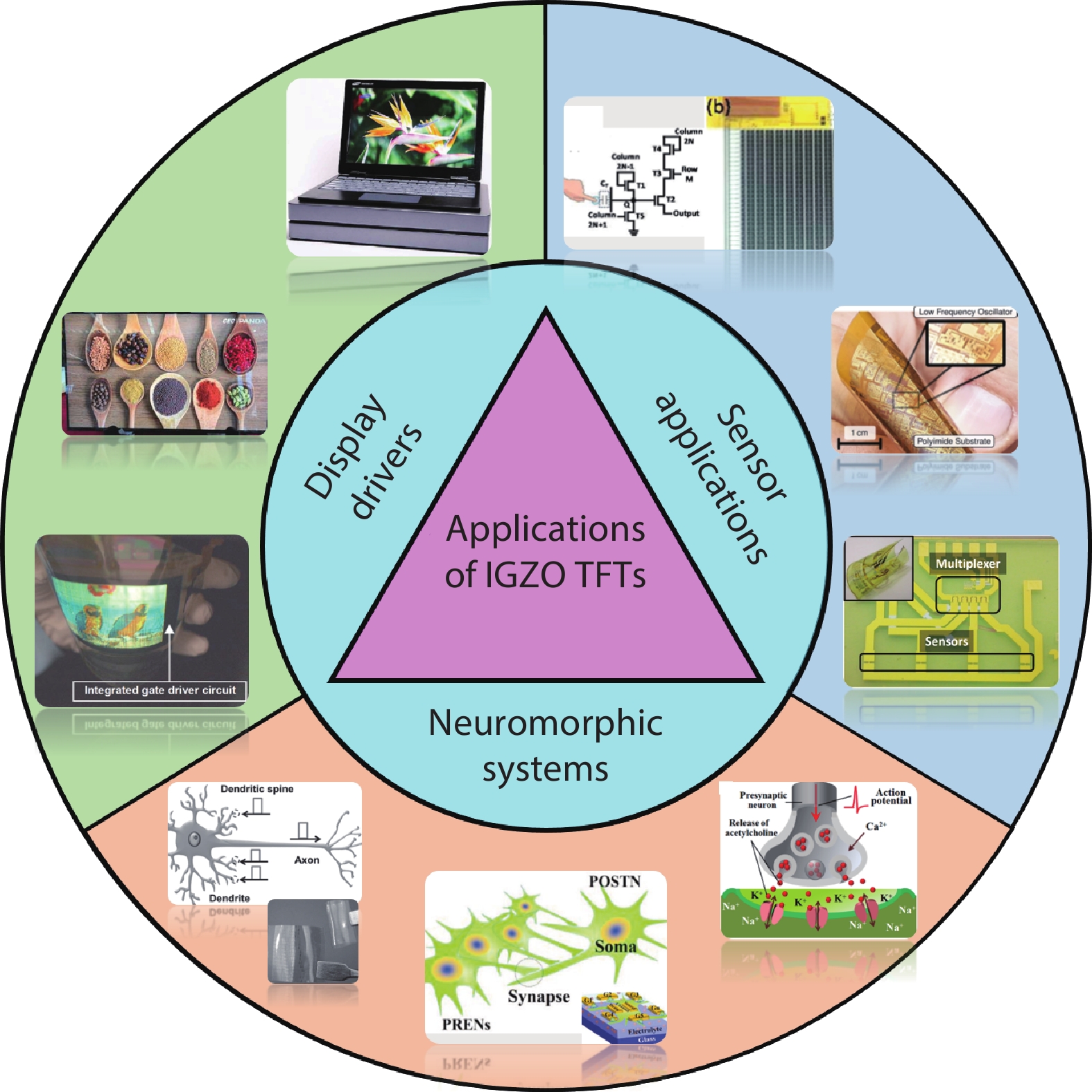
 DownLoad:
DownLoad:
